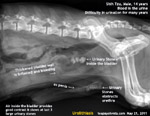The wait-and-see client
demands an injection in dogs seriously ill
Dr Sing Kong Yuen, BVMS (Glasgow), MRCVS
Date:
21 May, 2011 |
 toapayohvets.com toapayohvets.com
Be Kind To Pets
Veterinary Education
Project 2010-0129 |
I had two cases in the last
2 days of clients instructing me to give an injection and some
medication.
Case 1. Pyometra in a female dog
The woman brought her dog that was not eating and passing
smelly vaginal discharge for more than two weeks. Now not
eating. Tired. I palpated the swollen abdomen around 4 times
and the female Spitz gave up being gentle and started to curl
up her lips to warn me not to do it any more. "Just give an
injection and some drugs," the woman whose son was my son's
classmate instructed me. I suspected closed pyometra which is
a life-threatening disease - an infection of the womb.
I still remembered a recent case of the "Vets Who Don't Spay
Big Breeds" where the cross bred was euthanased due to poor
prognosis. The owners were referred by their vet to a
brand-name veterinary practice and could not afford the fees.
Much time had been wasted and the dog was no longer standing.
Kidneys became infected. As the prognosis was poor, around 40%
of survival, the owner decided not to operate and instructed
euthanasia. This case quite upset me for this was really a dog
that could have been saved if the family vet had tried not to
be a one-tracked mind, always referring big breeds to an
expensive surgery when his clientele comes from a
neighbourhood not in the upper-middle class of Singapore.
Now, this woman demanded an injection. I did not do it as I
advised X-rays and blood tests first to aid in the diagnosis
of pyometra. She phoned her husband first she said. The
husband and I exchanged words over the phone. He then asked
his wife to go to another vet.
Case 2. Urethral Obstruction in a male dog
In this case, the 14-year old Shih Tzu had passed a lot of
blood in the urine and had difficulty peeing for many years.
"This is usually urethral obstruction, with stones blocking
the urine flow," I said to the woman of over 50 years of age.
But the owner said: "Just give my dog an injection and
medicine. If the dog still passes blood in the urine, I will
come back again. This wait-and-see behaviour is sometimes
presented by the owners who don't want to be frugal.
Now, should the vet give what the customer wants? If not, the
customer will "think about the advices to do X-ray and blood
tests" and then goes to the competitor.
This is the type of ethical and moral dilemma. The vet can milk
the client by doing what she wants. Revenue generated. The dog
would have to come back again as the drugs will not work. This
is obvious to the vet but the client demands an injection.
I
know the medicine will not work and refused to obey her
wishes. The woman insisted. So there was an
impasse. Other clients in the waiting room watched and
listened.
She exited the waiting room and went outside to phone or
consult somebody, probably her family or husband carrying the
dog with her. I had asked Dr Vanessa to handle this case but I
would keep an eye on this case.
This was going
to be a hot potato if not handled professionally by me as the
initial contact for this owner. This old dog could die
due to delay in treatment as he is already 14 years old.
I mean, if
I give the injection and medication as requested, I will earn
my keep. However, this
dog will not recover. The other family members will start to curse
the vet for incompetence especially if the dog were to die
from renal failure and infection when sent to the competitor
and treated belatedly.
The competitor would cover for himself
or herself by saying that I should have had done the blood
test and the X-ray and give proper treatment early. If that
had been done by me, the dog
would have been alive. Not just give an injection and some
antibiotics. What an incompetent vet!
Well, to make a long story short, the owner agreed to the
X-ray which I told her was not necessary if she wanted to save
costs on veterinary surgery. She did not believe my diagnosis
of urethral obstruction and so she finally agreed to the X-ray.
A
surgery by opening the bladder and getting out the urinary
stones and pushing back the stones in the penile urethra into
the bladder would save some money for the cash-strapped owner.
Furthermore, the procrastination is not good for the sick dog
as the kidneys may get damaged, inflamed and infected. This is
the real world and there is not much the vet can do for the
poor dog.
"Suck out all urine," I said to Dr Vanessa as I
passed the case for her to follow up. "Do a urine test.
This is mandatory. Pump air into the
bladder and the stones would be seen clearly." She said: "The
cathether cannot be passed into the bladder, so there is a
urethra obstruction." Later she told me that another catheter
could pass into the bladder. My assistant Min showed me a
bottle with around 20 ml of
bloodied urine. This would be sent to the Laboratory for urine analysis
and a report would be given to the owner later (as part of
evidence-based medicine).
The X-ray showed around 5 stones in the os penis and
around 3-4 large urinary stones in the urinary bladder. "How you manage this case
is up to you," I passed the case to Dr Vanessa as this is
one case we would collaborate.
My diagnosis was correct without the need for the X-ray in
order to save the owner some money. In some HDB heartland
households, any veterinary fees over $50.00 is considered
expensive, from my years of practice. However X-rays are a
part of evidence-based medicine and give a more convincing
proof to the owner as shown below.
 |
pH=7.0
SG = 1.023
Bacteria - present
Crystal - nil
Red blood cells ++++
White blood cells ++++ |
|
X-Ray shows excellent contrast when air has been
syringed into the bladder |
Urine Test from the Laboratory |
|
|
Advertisement |
|
|
|
 More
info at:
Dogs or
Cats More
info at:
Dogs or
Cats
To make an appointment:
e-mail
judy@toapayohvets.com
tel: +65 6254-3326 or 9668-6469 |
 toapayohvets.com toapayohvets.com
Be Kind To Pets
Veterinary Education
Project 2010-0129 |
|
|
 TOA
PAYOH VETS
TOA
PAYOH VETS TOA
PAYOH VETS
TOA
PAYOH VETS